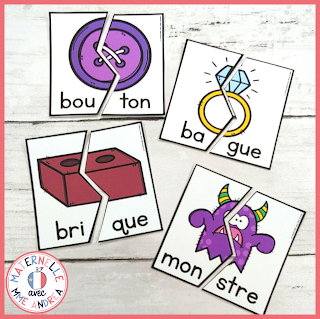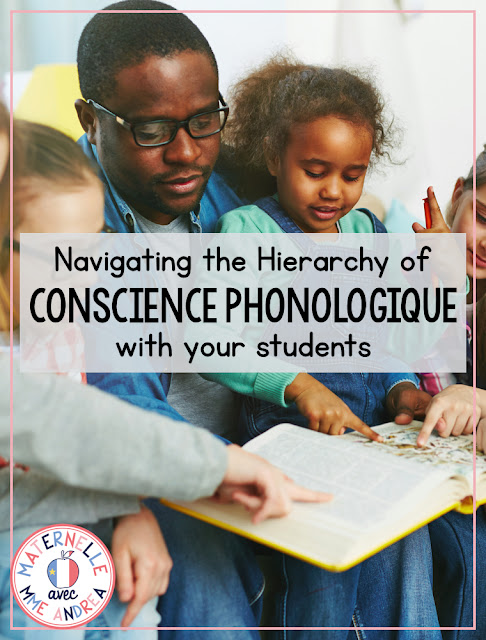If you read last week’s blog post, then you know that I shared some tips with you for practicing phonemic awareness skills with your students.
Today, I will explain each of the components that you will want to evaluate and practice. These components are what I refer to as the hierarchy of conscience phonologique.
When we are teaching our students, we want to start with the easiest component. Then, each following component will become more complex and difficult.
You don’t have to practice in order, though, and each skill should be practiced all throughout the year.
Because every student is different and is at a different place in their development, the hierarchy will help you manage your expectations for what your students will be able to do.
Some students will be able to do some or all activities without support, and others will need support from you.
Each step corresponds with the age at which a student should be proficient with that step.
Interestingly, the step for blending 2-3 phonemes isn’t until age 6, and yet, depending on the province in which you teach, we are often expected to teach our maternelle students to read up to a level where they would need to be able to do this in order to be successful.
Of course, some students are able to and enjoy doing activities that correspond to higher steps. That’s why it’s important to evaluate your students and their strengths/areas to work on. This will help you form small groups.
The six steps are:
- l’Écoute
- Rimes
- Isolation
- Segmentation
- Fusion
- Manipulation
L’écoute:
This is when we will be working on developing our students’ listening skills. You can do this by having them listen to or for animal/environmental sounds, and/or you can have them listen for certain phonemes.
Les rimes :
We want our students to be able to identify whether words do or do not rhyme and to be able to produce words that rhyme with a given word. This skill should be mastered between ages 4 and 5, depending on the skill.
L’isolation des sons:
This is when we want our students to be able to identify a beginning, a middle, or an ending sound. Five-and-a-half is the age when we want our students to be experts at matching and isolating beginning sounds, so that’s my big focus in maternelle.
La segmentation des sons:
Our students should be able to segment sentences into words, words into syllables, and syllables and/or words into phonemes. This skill should be mastered by age 6.
La fusion des sons:
This step is basically the opposite of la segmentation. We want our students to be able to put syllables together to form words and to put phonemes together to form syllables and/or words.
La manipulation des sons:
This is the trickiest step, and we don’t expect our students to be able to master this skill until age six-and-a-half (grade one).
If a student can successfully manipulate sounds, then they are able to switch out phonemes within words to create new words.
You might ask them to add, switch, or delete a syllable or a phoneme from a word. For example, they could change a sound in the word “cage” to end up with the word “cane” or change “cane” to “cone.”
We might also ask them to delete or remove a syllable from a word. What would be left if we took “ton” out of “chaton,” for example?
Next steps
We may not require our students to master all of these skills in maternelle, but we definitely want to practice them all throughout the year.
Practice makes perfect and will help more students be proficient. And, as I said in many previous blog posts, students who have strong conscience phonologique skills are more likely to become strong readers and writers!
Be sure to check back next week, when I’ll be continuing my series on conscience phonologique, and sharing some of my best tips for practicing!
Other posts about conscience phonologique:





